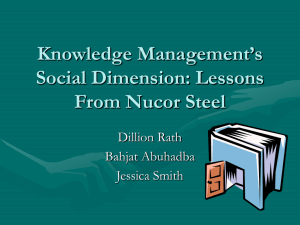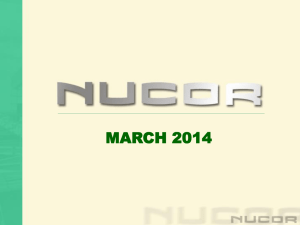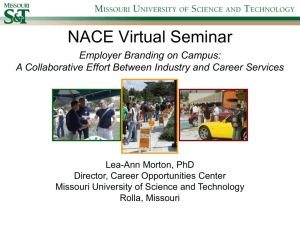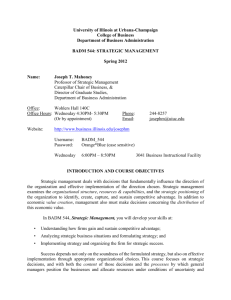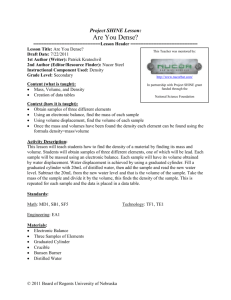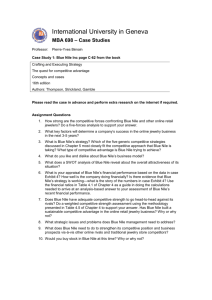Nucor Corporation - Salem State University
advertisement
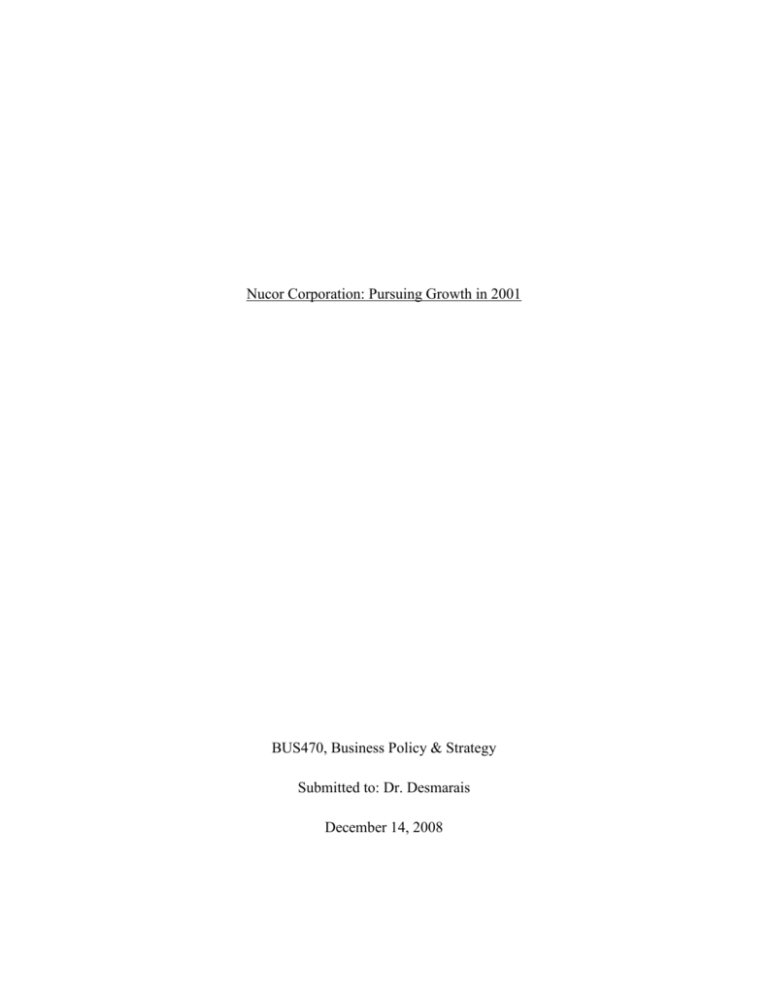
Nucor Corporation: Pursuing Growth in 2001 BUS470, Business Policy & Strategy Submitted to: Dr. Desmarais December 14, 2008 I. Executive Summary The North American steel industry is in decline, for the first time two decades. Macro- environmental and industry forces have caused steel prices to drop while costs of production and labor wages are rising. Many companies have filed for bankruptcy and there is significant industry consolidation occurring, primarily in Europe and Asia; the threat of these huge conglomerates entering the US or other profitable markets is inevitable and in progress. The current industry climate provides financially-healthy companies an excellent opportunity to enter into a phase of acquisition. As “Greenfield growth” is only limited for large domestic steel producers, taking advantage of purchasing opportunities of bankrupt and undervalued companies seems to be a increasingly worthwhile activity. Thus far, Nucor has been a leader in the industry due to their organizational culture and management values. Nucor has also made switching costs for buyers high and they are a first mover in implementing new technology. An analysis of the industry, its opportunities and threats, Nucor’s competitive capabilities, and Nucor’s strengths and weaknesses has led us to suggest the following recommendations. Each recommendation presents information about the current environment, its context, and how we recommend Nucor proceeds. Each also contains the tools needed to measure their success. We recommend that Nucor: 1. Maintain current domestic business and functional level strategies 2. Return to lean management structure: The present management structure that Nucor has acquired is a weakness for the company. In addition, stock prices fell by ten percent in 1999 once the management configuration changed from its original design. With that, Nucor should restore its management back to its original composition. This will leave Nucor less susceptible to losing stakeholders’ interest in the company. 3. Implement strip casting technology in its mini-mills: Nucor should use their strength of continuously staying ahead of their domestic rivals in implementing new technologies to pursue the opportunity of using new strip casting technology within their production. Strip casting is a process which produces a much thinner strip of steel while also reducing the firm’s costs. After implementation, Nucor should closely monitor the costs involved in strip casting and be sure there are actual savings to the firm. 4. Integrate DRI into production: Nucor’s dependence upon scrap steel is a weakness and they are susceptible to market trends. There is presently nothing to defend against the threat of high scrap prices. DRI provides a consistent alternative that produces superior quality products while cutting costs. After implementation, Nucor should compare their success to rivals and analyze DRI products’ profit margin. 5. Acquires domestic rivals: Nucor is a very liquid company which helps the company pursue the opportunity of acquiring cheap property, plants, and equipment. Nucor should find a suitable company with the proper technology and location. Once a company is acquired, Nucor should implement their management values and culture in order to turn the plants successful. To determine if the acquired plant is successful, Nucor should compare the acquired plants financials to Nucor’s past successful acquired plants. 6. Enters India through M&A: Acquisitions of companies with mills capable of facilitating strip-casting, established or easy-to-establish distribution channels, and located near a target city in India are the primary prospects. Due to its growing infrastructure and relatively stable macro-economic future, India proves to be the best location for the next phase of Nucor’s growth. Joint-ventures may be acceptable under the conditions that the joining company is subservient in strategic and tactical decision-making and that Nucor has control over the re-investment of earnings from the venture. II. Macro-environment In 2001 the US ended a phase of tremendous growth, created largely by the increased retail consumption, increased activity in commercial and residential real estate markets, and a booming technology sector. The sharp drop in equity prices that occurred post-9/11, and a tightening of credit markets, caused the Federal Reserve to loosen monetary policies and induce spending. This was reflected in the discount rate being dropped to as low as 1%. Also during year, unemployment saw an increase of 1.8%, which ended a long period of decreasing unemployment in the US. There was a slowing of the global economy in 2001, as growth decreased from 4.7% to 2.4%. Imports and exports, particularly between the US and developed Asian countries, also saw a significant decrease after the terrorist attacks of 9/11. India, the second-fastest growing Asian economy behind China, also saw a decrease in production due to increase energy prices. Also, the country withstood several shocks during the year, including a severe agricultural drought and a large earthquake in Gujarat. A political concern is the unionization of the workforce that has taken place over the last several decades. It has allowed the workforce for more bargaining power, and subsequently, increased wages and benefits per capita of unionized workers. Those workers who do not enter the union are at a disadvantage in terms or bargaining power, however can take advantage of job offerings at non-union shops. US steel companies benefit from generous government subsidies that protect help protect their businesses from the threat of new entrants. Also, the US has a fairly lenient taxation of corporations when compared to most other developed nations; the corporate tax rate is roughly 35%. Complex enterprise software is helping to reduce costs of production among many industries. The better management of supply-chain has in some cases been a distinctive competency that has lead to their domination of an industry; Toyota, Walmart, and Dell are all examples. Enterprise software has a variety of uses and provides tremendous value to the steel industry. Steel-casting is decidedly the future of steel production technology, and has been implemented in 11 companies in Europe. The improvement in the quality and finish of the product, along with the savings in cost per unit of production, shows great promise in reducing profit margin and creating entry into new markets for finished steel. Please refer to Appendix A for a thorough analysis of the stakeholders. III. Industry analysis The North American steel industry is currently in a period of decline. Foreign companies are dumping cheap product in American markets due to a lack of import tariffs. This is driving domestic steel prices down despite high production costs. Energy costs are also rising. Coupled with a recent economic recession, this is causing many companies to go bankrupt. Furthermore, growth of the steel industry in China and other global economies is producing high materials prices. It is increasingly difficult to find consistent suppliers of these materials as well. Demand is becoming stagnant. Markets are ordering products that meet increasingly specific customer specifications. Finally, growing environmental concern is forcing companies to review their practices to ensure compliance. There are fewer rivals in the industry, and due to industry consolidation their individual size is growing. U.S. Steel, International Steel, Mittal and Nucor are the main competitors in the United States. There is not much differentiation as they contend with similar products and sell to similar markets. They also use similar materials so they must compete over suppliers. The rivals in the industry all recognize the need to have a technological advantage to produce stronger and lighter products more efficiently, and the race to be technologically advanced is a main point of competition in the industry. There is low threat of entry into the North American steel industry. The industry is in decline and there is capacity surplus. There are high costs and a significant learning curve associated with entry. Exit barriers are also high which causes companies to compete despite low or negative return on investments. Substitutes for steel such as plastic, wood, concrete and other metals threaten the industry. Steel remains the most important industrial material, however. Consumers prefer it as long as it remains cost efficient to use. They prefer it because it is formable, reparable, paintable, energy efficient to produce and fire resistant. Furthermore, steel companies have adjusted their products to meet such market needs as corrosion resistance and weight limits. Suppliers to the industry provide iron ore, limestone, metallurgical coal, and scrap iron and steel. Scrap steel is becoming more inconsistent in both availability and price. It is very expensive for a company to switch suppliers, as they would have to build new plants to use the new material, so they are unlikely to do so. Raw materials are a large part of company’s costs, and small fluctuations in prices resound dramatically among competitors. Many companies use backwards-vertical integration. Direct reduced iron (DRI) is a possible substitute to raw materials that has seen a growth in use worldwide. Buyers have bargaining power due to oversupply and decreased demand in the domestic market. The largest buyers are transportation, construction and oil and gas industries. They are massive buyers and have constant need of product. They also have good knowledge of the product. The buyers do not use backward integration. Buyers’ switching costs are low, but they are unlikely to switch to other products because steel provides better quality and performance. The five forces create intense rivalry in the market. Mini-mills are continually emergent and can be found in 50% of the states. Steel mills have +/- 10% overcapacity. Additional minimills coming on line will create an additional 10% capacity. This growth is despite an expected decline in demand. Current conditions foreshadow possible price wars and may cause many unprofitable rivals to stay in business. An unprecedented number of steel producers have filed for bankruptcy. Among them are Bethlehem Steel Corporation and LTV, who were the country's third- and fourth-largest steel producers respectively. Many of the world's economies were in recession in the late nineties, causing a surge in the import of steel to the U.S.’s strong market. With unfair subsidies from their governments, foreign steel producers were dumping steel in the U.S. market at cut-rate prices. In 1999, the United States rejected a proposal to put restrictions on imports. A 75% capacity utilization caused three European companies to merge to form the world's largest steel producer. Two Japanese companies did the same to form the second-largest steel producer. These new mega-steelmakers have greater capital and market share than U.S. competitors, imposing a large threat. Terrorist attacks on September 11, 2001 reduced the demand for steel even further as the construction and transportation industries slowed. Efforts were underway to negotiate a worldwide reduction in steel production. In addition to cheap imports, U.S. steel producers were facing higher energy prices, higher material prices and decreased availability, increasingly tough environmental rules and a changing cost structure among producers. Steelmakers around the world were watching the development of continuous strip casting technology, which was believed to be the next leap forward for the industry. This would eliminate the slab-casting stage and all of the rolling in the hot mills. Strip casting was already being adopted around the world outside the U.S. Rivals in the steel industry are very liquid, and have capital to spend. This is one of their competitive capabilities. Another is that rivals have high amounts of vertical integration, and significant amounts of horizontal integration. They also are able to use economies of scale in almost all aspects of the business. Companies in the steel industry must keep their costs low in order to remain successful. While doing so, however, they must also retain the high quality and high performance of their product in order to remain preferable to substitutes. Low costs and quality product will also help companies remain competitive in an industry which is being flooded with subsidized imports, another key success factor. The steel industry is also becoming more global, and rivals must grow in a global market. Finally, it is essential to develop the latest technological advances in production to be successful. IV. Critical issues facing the steel industry In a struggling domestic economy the United States steel industry faces multiple critical issues. In the late 1990’s a foreign reign of steel imports flooded the market at a greatly discounted rate. Foreign competition, subsidized imports, and major foreign merges between large steel companies are a major threat to the domestic steel industry. Nucor and other U.S. companies reduced prices to compete against the sudden surge of import steel. The U.S. secretary of Commerce, William Daley, stated, “I will not stand by and allow U.S. workers, communities and companies to bear the brunt of nations’ problematic policies and practices. We are the most open economy of the world. But we are not the world’s dumpster.” The commerce department concluded in March 1999 that steel companies in six countries had illegally dumped stainless steel in the United States at prices below production costs or home market prices. In June of 1999, The Wall Street Journal reported that the U.S. Senate decisively shut off an attempt to restrict imports of foreign steel despite the complaints of U.S. steel companies that a flood of cheap imports was driving them out of business. The fluctuating scrap and commodity price is another critical issue that the industry faces. Electric arc furnace mini-mills that used scrap steel as their basic raw material emerged in the United States during the 1970’s. As mini-mill technology advanced throughout the 1970’s and 1980’s they were averaging a 14 percent return on equity while integrated steel companies were only averaging 7 percent. Some mini-mill firms, such as Nucor, were achieving returns on equity investment in the 25 percent range. In the 1990’s mini-mills tripled their output, driving the market share of integrated mini-mills down to around 40 percent. Over the past three years the price of scrap has gone from $150 per ton, to $100 per ton, and currently back to $120 per ton. With the most profitable divisions within the steel industry, mini-mill production, relying on such an unstable commodity as scrap steel, new forms of steel production need to be designed and implemented. The impending recession in the U.S. is another major critical issue the steel industry faces. The demand for steel rapidly slows as new car sales fall and budgets for maintaining and building infrastructure shrink. The impending recession combined with the imports of foreign steel into the U.S. market led to substantial excess production capacity and net income losses of nearly $4 billion dollars in 2001. Between October 2000 and October 2001, 29 steel companies in the United States, including Bethlehem Steel Corporation and LTV Corporation, the nation’s third- and fourth- largest steel producers, filed for bankruptcy protection. Since 1997, nearly 47,000 jobs in the U.S. steel industry have vanished. The increasing environmental concerns are the last critical issues facing the steel industry. The four major environmental issues are air emissions, wastewater, over production of solid waste, and large energy consumption. Air emissions include contributions from every stage of the steel making process. Particles are generated at virtually every stage, but most heavily by coke making and blast furnace operations. Wastewater from coke making has high contaminant levels, requiring extensive removal and treatment before disposal. The production of solid waste from the steel industry presents problems due more to the volume of the waste generated rather than the hazard present in the waste. The steel industry sector is also a very large consumer of energy and as such, is a major contributor to green house gas emissions. According to data collected by the U.S. Department of Energy, and from green house gas inventory data from the EPA, “The iron and steel sector was the second biggest contributor to green house gas emissions of all industry sectors, second only to petroleum refining. V. Nucor’s competitive capabilities i. Business strategies Nucor follows a low-cost provider strategy, as it primarily aims to provide a somewhat generic product to customers, at the lowest price available in the industry. Price sensitivity is high in the steel industry, as price is the key differentiator to a product with such indistinguishable features. ii. Functional strategies All functional level strategies are linked directly to its broader strategy of being the lowest cost producer. It achieves this by committing to tried-and-proven value chain components, which allows them to not only compete on price, but generate better profits margins, and grow at a faster rate than its main competitors. The one key aspect to Nucor’s successful value chain is its expertise in the implementation of technology- a distinctive competence. Nucor displays an ability to adopt new machinery and experiment with different permutations of production, to identify the lowest cost methods that generate steel of the same quality. This focus on mastering new technologies presents it the positive effects of producing at greater economies of scale. The electric-arc furnaces being employed also follow the concept of a continuous focus on increasing the effectiveness of the resources available. The switch to using EAF’s eliminate the need for the mining and cooking machinery needed in integrated mills. Instead, DRI and scrap steel flow continuously to the furnace, then sent to the continuous casting and rolling system, emitting a finalized product. Using this method, Nucor avoids the added workforce, extra queue times needed for added phases, and the costs of added production processes needed to run integrated mills. Locations of steel mills are chosen based on a close geographical proximity to customers and also in areas where there is little union influence. Building personal and stronger relationships with customers is easier when they are close by; in Nucor’s case, many of them reside on Nucor’s “campus”. The immediate savings for customers comes from their greatly minimized shipping costs and had their products delivered quickly using the 150 trucks ready for delivery. This significant benefit along with the personal connection created by doing business in this manner, translates in to high exit costs. This affords Nucor an invaluable competitive advantage, securing long-term customers. Secondly, the use of a unionized workforce allows flexibility in pay, as Nucor has employs a results-based compensation system. Maintenance and operating employees can earn between 80-150% of their actual salaries, based on their performance; the increased efficiency created by this form of compensation ultimately results in lower costs that are translated to the customer. The overall frugality of Nucor’s management is tied to a focus on reducing costs. The headquarters employs 125 employees, on the average earning 25% less than a similarlypositioned employee at a competing company. Aside from the stripped-down incentive program for executives, there is a minimalist approach to all paperwork, business-trip expenses, and anything else that did not directly add significant value to the company. iii. Assessment of strategies Streamlining the management and production-line functions have resulted in a steady decrease in cost, and a steady increase in production per worker. In Nucor’s Florence Joist plant, the tonnage produced per man-hour was 0.163 in 1977 and was 0.241 in 2000. Also, Nucor has been able to actually slightly increase their prices while requiring less raw material per unit of finished product (while maintaining the same customer base); this ultimately leads to an increased margin, which is the primary indicator of operational effectiveness (and one that is even more indicative when used to assess manufacturing companies). By analyzing the income statements of Nucor and it’s main competitor US Steel, we notice a significant difference in operating efficiency. Nucor’s only operating costs are administrative, and are consistently 15-20% of the gross profit. Whereas US Steel is consistently spending roughly a third of gross profit, between selling and general administrative costs, one- time costs (unplanned), and other unlisted costs. The difference in the ratio is significant, and also the types of cost show that US Steel is consistently making unplanned expenses (poor management). The decision to stray from the steel-industry norm of absorbing shipping costs and translating them to customers, proved to be a brilliant one. Five customers at the Arkansas plant integrated their supply chain with the plant, and in aggregate, consumed 60% of the output of the plant. This integration of supply chain is a testament, due to the significance of the action, to the strength of the relationship created and the customer’s dependency on low prices. Due to the success of the company thus far, it is recommended that the company retain the business-level strategy and make very little, if any, changes to the functional level strategies going forward. iv. Resources Nucor has valuable tangible and intangible resources. Nucor’s access to its distribution channels and its plant and retail locations are assets to Nucor. Nucor had its own fleet of 150 trucks. This reduces overall freight and delivery costs; it also ensures on-time delivery for buyers. Also plants were located in rural areas near the markets they served. Nucor had employees who were talented and knowledgeable in key areas which amounted to a competitive advantage. Ken Iverson’s vision for the company was invaluable to its success. Also, Dave Aycock, the former owner of Vulcraft, devised an incentive program that formed the foundation of Nucor’s compensation program in both the joist and steel plants. His number one purpose was to maximize the value of the company for its stockholders and employees. Also John Correnti previously worked for U.S. Steel. He was in charge of operations at Nucor. He also became GM of Nucor and doubled production, and when Iverson became ill, Correnti was elevated to CEO of Nucor. This talented group of executives added to the intangible assets within the company, and also added value to the company. They were able to manage Nucor successfully all while keeping their production and final steel cost competitively low. Not only was the management an asset to Nucor, the workers were assets to Nucor. The workers developed technology to ease the production process and keep costs low which made Nucor’s business strategy possible. v. Value chain Nucor has strong relationships with its suppliers and buyers. Nucor should improve certain issues within the value chain to make their overall production more efficient. For example, in the purchasing and logistics, Nucor should strive to have more control over the supply of raw materials to their plants. They should also acquire a strong relationship with a producer of scrap metal or metal substitute in order to reduce costs and create efficiency in the overall production process. Nucor’s operations are strengths for the company because Nucor does invest heavily on its employees. For example, Nucor maintains a highly motivated, productive, flexible, and innovative workforce. They also have a highly talented management team. Through the use of these intangible assets, Nucor should strive for innovation of new technology. For example, Nucor should look into systems such as DRI, and strip-casting. Through implementation of these new products and processes, Nucor could sustain a competitive advantage. Distribution and outbound logistics in the US is a definite strength for the company. Nucor has strategically placed its plants next to its main distribution channels. They have created plant campuses across areas in the US. These co-locations next to major customers have significantly reduced the need for an advanced distribution and outbound logistics system. They have low storage which results in lower inventory costs. They also maintain a large fleet of 150 freight trucks that ship and distribute their products to their customers. Despite Nucor’s advances in domestic logistics, Nucor can definitely improve their ability to export steel to emerging markets abroad, such as India, and Brazil, where the demand for steel is rising. Within the marketing and sales of Nucor, there are some important issues that need to be addressed. For example Nucor does not have an aggressive marketing team. Their sales also depend on close and long-term relationships with their customers. Although the marketing is not aggressive, Nucor is able to maintain their customers based on their sales. Accordingly, Nucor needs to better understand the cyclical demand for steel products. Then, market research should be done to better understand the future demand cycles. Also, due to Nucor’s decentralization, certain aspects of sales and marketing are being duplicated. Therefore some coordination between divisions is needed in order to capitalize on economies of scale for purchasing. Nucor’s service is very efficient. They have mini-mills that allow their production process to far surpass that of their rivals. They also have direct relationships with suppliers and engineers of certain steel products. These divisions are able to identify what customers demand, and also discover solutions to design problems and other specifications. In addition, Nucor does not house an internal research and demand department. However, Nucor is one of the fastest steel companies to adopt any new steel manufacturing technology, such as mini-mills, and continuously improve on them. For that reason, Nucor should capitalize on its strong work culture and technology as a way to continue their competitive advantage. Moreover, Nucor’s human resource department has come up with a team-based incentive program that ultimately is performance-based. The company promotes constant training and job-rotation in order to make its employees the most motivated, productive, flexible, and innovative workforce in the steel industry. In terms of general administration, Nucor prefers to keep their structure relatively consolidated. This approach allows Nucor’s employees to remain autonomous. This allows Nucor’s operational and overall costs to remain low, which is another competitive advantage for Nucor. Taken as a whole, Nucor’s value chain is strength for the company. vi. Financial performance & capabilities Although this year does not seem to be the best year for Nucor, the slowing economy presents an opportunity for Nucor considering their financial strength. Their gross profit margin fell from a consistent level between 13% - 14% for the past four years to 9.68% this year. However, Nucor has been consistently profitable with their net earnings hitting a record high of $310.9 million in 2000. Their cost of goods consisted of approximately 90% of their net sales this year. This is up 5% from the previous year. Between the years of 1995 and 2000, Nucor has maintained their cost of goods constituting for approximately 85% of their net sales. Nucor’s return on equity fell from 14.59% in 2000 to 9.48% in 2001. This was mainly contributed by the fact that Nucor issued approximately 233,000 additional shares in 2001 after buying back approximately 10,000 shares in 2000. This helps explain why their dividends declared per share fell drastically from $0.60 a share in 2000 to $0.17 a share in 2001. They now have many more shareholders to distribute dividends to therefore it will significantly decrease the dividend as well as the return on equity. Nucor has been able to keep its debt levels low and under control. It has very limited long-term debt, which places Nucor in a great position to start several significant acquisitions. The bold move to increase their market share through making investments helps to ensure that Nucor will have future growth and profitability. The economy is going through a tough time and within the steel industry there are high levels of competition from cheap imports flooding the domestic market. Nucor is in a strong financial situation to gain an advantage over their competitors by spending their available capital on growth and technology while most of the industry is cutting back on expenditures and more focused on solutions to the international steel market competition. vii. Strategic issues facing Nucor The entry of large consolidated steel companies from Europe and Asia into the domestic market is a primary concern for Nucor. Large companies in Luxembourg, France, Spain, Japan, and India, are beginning to create huge conglomerates that threaten Nucor’s domestic market share. Companies of this size, if integrated correctly, will enjoy economies of scale previously held only by US Steel and Nucor, and could pose a threat to Nucor’s lowest-cost status. Many companies were clearly paying attention of the strides taking place at Nucor. National Steel, a smaller Japanese owned company, showed a similarity to Nucor in it’s management versus labour model; the basic concept of paying based on quality workers (and accepting unions) and not on seniority. A large and good implementation of such a system in the US, where unions do not have a good relationship with corporations, could potentially steal customers from Nucor. PT Ispat Co. displayed the insight to enter into minimills and DRI very early, and showed great success in Indonesia using these tools. Internally, the centralization of the management began occurring in 1998, with a new level of EVP’s presiding over regions of several plants. Intuitively, this creates a disconnect between the decision-making body (previously only the general manager of the plant) and the workers. The issues that will occur due to all the changes in chain-of-command and reporting can be very harmful to the culture. A proposed return to a leaner management structure, while anticipating for new styles of business in the future, has five layers: 1. President &CEO: Who will be responsible for strategic planning & business development. 2. Executive VP: Responsible for strategic planning and business development of joint ventures, acquisitions, and merging opportunities. 3. International Business Executive: Responsible for all international R&D. 4. GM/ Plant Manager: Will operate each plant as independent business 5. Supervisory/ Professional: Develop quality products, and implement new technology viii. Management values The ability that a company has to establish and internal ‘fit’ with its’ management and employees undeniably leads to short-term growth as well as long-term success. Nucor was capable of establishing this fit with its management team due to their values and their original attainment of Ken Iverson. Ken Iverson became the president and CEO of Nucor. With his new position he was able to uphold the central values that were most important to him, and somehow make them important to his entire workforce. His management strategy was based on two primary goals; improving efficiency, and nurturing strong employee relationships. Iverson believed in employee fairness. With this he was able to uphold a cooperative and productive workforce by instilling values such as honesty, autonomy, trust, communication, self-motivation, and simplicity. Each employee that did not mesh well with the ‘fit’ of Nucor left the job on their own behalf. This shows the strength of Nucor’s management values, and also how Nucor has an intangible advantage over their rivals. Nucor can gain strength in global markets by allowing their management values to continue into their joint ventures and acquisitions. Also, over time Nucor’s original management structure changed, and additional levels were added. These changes surprised investors and led Nucor’s stocks down by nearly ten percent. By merely reverting back to the unrefined Iverson structure, and maintaining the same values, Nucor will be able to continue its success well into the future. ix. Organizational culture Nucor is a company whose strong organic approach to culture, that stemmed from Iverson, has allowed the company to become successful. Nucor reinforced short lines of communication, and also emphasized the importance of a decentralized management structure. Despite all of the changes that have been made, Nucor has kept a fairly consistent corporate culture. The emphasis of each plant was its ability to be run as an independent business, with a strong focus on entrepreneurship. Also Nucor lived its motto of, “failure to take risk is failure.” Nucor took chances in technology, and in the basic structure of the company. These chances have made Nucor into the success that it is today. In comparison its main rivals, Nucor is less hierarchal and more participatory. Each employee within a plant has greater knowledge and empowerment than any other individual in the plant. This individualistic approach was then integrated into team-based incentive programs, in order for everyone to continue to pull their own weight, and also to achieve high amounts of quality production at an efficient pace. Nucor also ran the company with a no-nonsense approach. Their focus was on their rivals, their own possessions, wealth and ambitions. Nucor also developed a recycling program that added attraction, stakeholder interest, and brand recognition. With that, Nucor was able to generate a company culture full of teammates, whose main goal is to take care of its customers. Nucor should continue to protect those corporate cultural values that have existed since the creation of the company; because their culture is a key success factor for them in both domestic and global markets.
